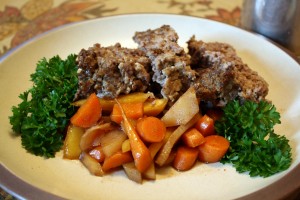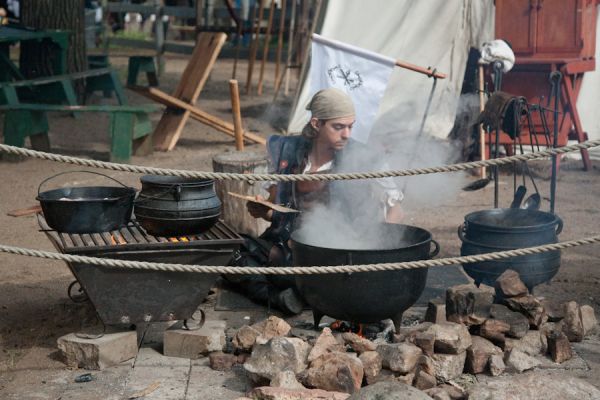From the July issue of Renaissance Magazine
Over the years, my historical research with cooking, recipes, and food has taken me to different cultures and tasting their cuisines. Occasionally, I will encounter a new tidbit of information that will surprise me as well as culinary professional colleagues and amateur foodies alike.
The modern meatloaf usually consists of a combination of bread or cracker crumbs, eggs, and ketchup; some other ingredients may be added to each recipe making it unique for the geographic region or various family traditions. Meatloaf has been with us for a very long time, but under different names.
The oldest recorded ground meat recipe can be found in Apicius, an ancient Roman cooking text. This recipe consisted of finely chopped meat (or mince), combined with pepper, garum (a fermented fish sauce popular In Roman cooking), and pine nuts while its center contained white bread crumbs soaked in wine. This mince was wrapped in a sheep’s stomach or upper intestines and then baked in a large oven.
Other versions of meatloaf can be traced to German, Belgium, and Holland 5th century recipes. These central and northern Europeans regional forms of meatloaf usually consisted of minced or ground pork, hard boiled eggs, and bacon with bread soaked in milk or wine to help form the hand-shaped loaf and then baked. These later forms influenced recipes from other cultures including the Middle Eastern kofta and Italian meatballs. All meatloaf recipes came about for the same reason; by adding various fillers including bread, rice, or oatmeal to chopped, minced, or ground meat, anyone could stretch a small amount of meat to feed others. Today, meatloaf has become a mainstay in the comfort food menus in many homes. In this issue of Renaissance Magazine, I am sharing a meatloaf recipe from 14th century England.

Meatloaf
2 lbs. (4 cups) ground or minced beef
1 cup of oatmeal
1 / 3 cup of red wine
4 eggs
1 /4 tsp black pepper
1 / 4 tsp of ground cinnamon
1 / 8 tsp ground mace
1 / 8 tsp ground cloves
Combine ingredients in large bowl and shape into a loaf or place in deep casserole pan. Add a pinch of the mace and ground cloves and bake for 1 hour at 350 degrees. Drain off fat and tip onto serving platter and slice up servings. Serves 4-6
Glazed Root Vegetables
4 cups of root vegetables, largely diced (carrots, rutabagas, turnips)
1/2 cup of brown sugar or honey
1/4 cup brandy
1/4 cup butter
1 tsp of ground cinnamon
1/2 tsp of ground clove
1 / 4 tsp ground ginger
Salt to taste
Cook vegetables in pot of water until tender. Drain water. In a separate saucepan, melt the butter over low heat and add the brown sugar or honey, cinnamon and cloves. Continue to stir, slowly adding the brandy to the sauce mixture. If honey is being used, the sauce will need to be reduced by one half. Turn up the heat to medium and add the root vegetables. Continue to cook over medium until sauce thickens. Serves 4.
Unlike the modern meatloaf recipes that have a saltier finish due to the use of ketchup, this recipe has a sweet/spicy finish due to the cloves, cinnamon, and mace. The oatmeal provides an even binder when combined with the red wine and eggs. I’ve also partnered this recipe with a side dish of Glazed Root Vegetables. Both dishes complement each other rather well and may be served with red wine.


 If you are one of the unfortunate people who do not have access to fire and can only use a stove, I will warn you that this can be a smelling and messy project.
If you are one of the unfortunate people who do not have access to fire and can only use a stove, I will warn you that this can be a smelling and messy project.